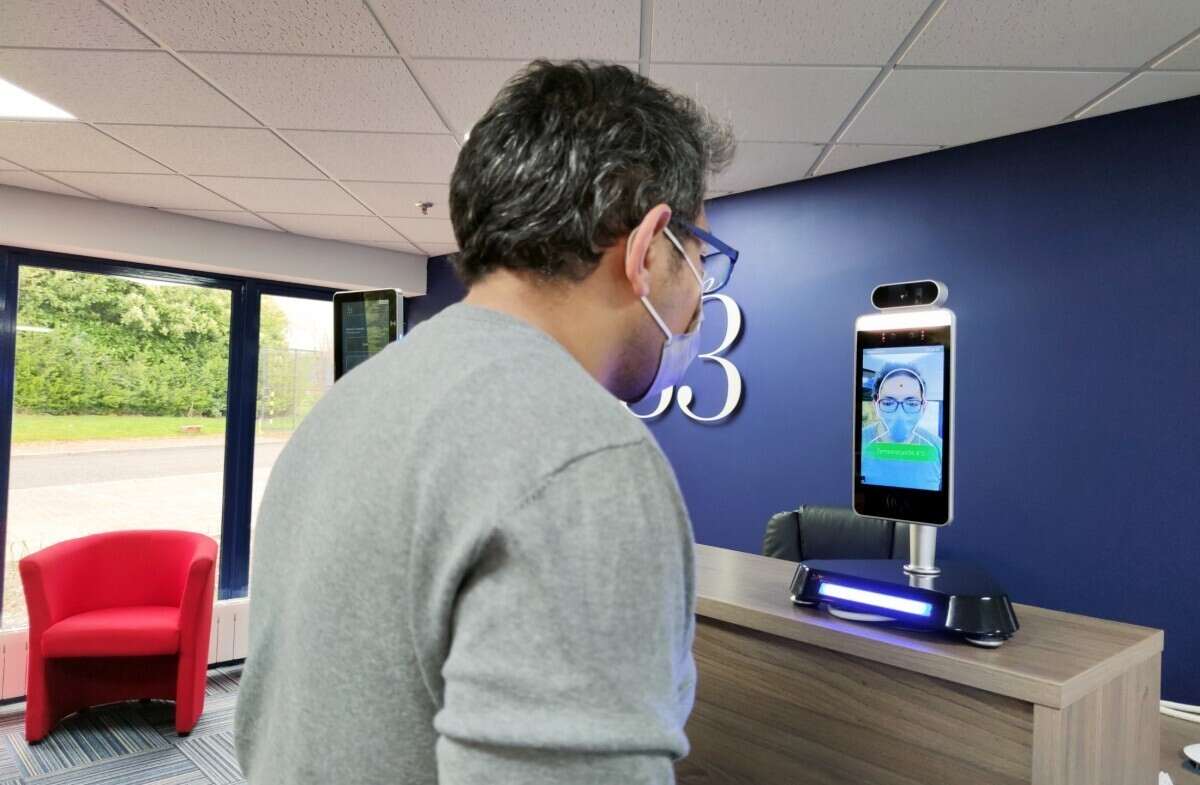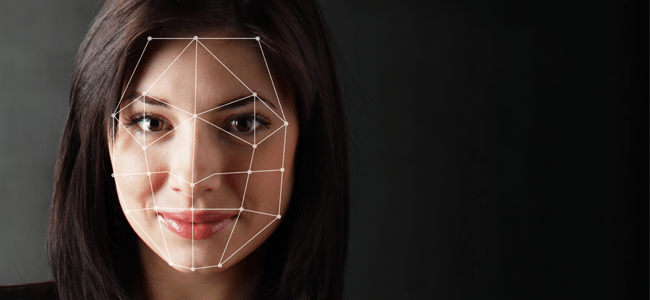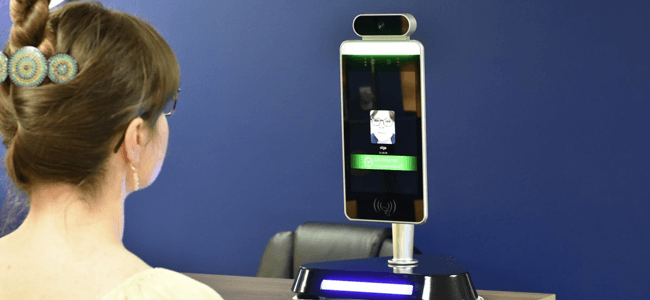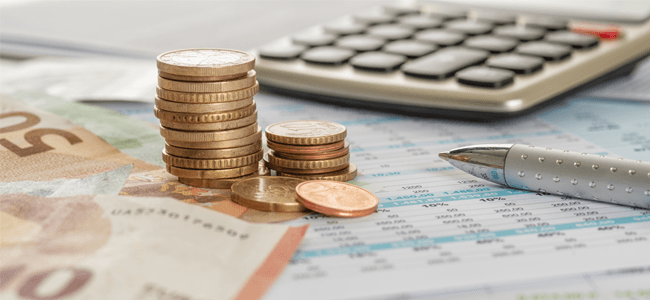
TEMPERATURE SCANNERS | 6 MIN READ
Temperature scanning kiosks offer businesses a fast and reliable way to re-open amid the COVID-19 pandemic and stay open. Additional API integrations also allow for these kiosks to be configured for uses that extend beyond just temperature scanning. Keep reading to learn what a temperature scanning kiosk is, how it works, and how it can be integrated into your business.
Not enough time? Jump to:
What is a Temperature Scanning Kiosk?
How Do Temperature Scanning Kiosks Work?
Can They Prevent the Spread of Infectious Conditions?
How Can They Be Integrated Into a Business?
What is a Temperature Scanning Kiosk?
Temperature scanning kiosks use a combination of facial recognition and infrared technology to quickly identify and scan an individual's temperature.
These devices can identify an individual and assess their temperature within a few seconds. This makes the kiosks suitable for mass temperature vetting purposes, for instance at large events like concerts or football games, or even for schools looking to quickly screen students as they arrive in the morning.
These kiosks are non-contact, which minimizes the contact that employees would have with visitors if employees had to scan visitors with a hand-held thermometer.
These kiosks use similar infrared scanning technology to thermal cameras, but instead of scanning the entire body, only the forehead is scanned. Since the temporal artery in the forehead is a good base for temperature taking, these kiosks function, in some ways, like a temporal scanner.
Temperature scanning kiosks also have less variability in readings because of the way they scan. These kiosks only scan one person at a time, and require that person to stand about 2 feet away.
This is a more accurate way of assessing an individual's temperature than using other mass temperature vetting methods such as thermal cameras, which scan groups of people at once from farther away.
RELATED: Temperature Scanners for Businesses [Types + Pricing]
How Facial Recognition Technology is Utilized

Facial recognition serves two functions with these kiosks: to identify and locate a person's forehead so the temperature reading can accurately be performed, and to historically track temperatures in user profiles.
Many temperature scanning kiosks allow an individual to create a user profile. With these profiles, one will be recognized in the system as a trusted visitor and their temperatures will be logged.
User profiles are useful for organizations such as corporate offices who want need to contact trace in the event that an employee becomes sick, or for companies who wish to restrict access to only verified users.
Since some kiosks have additional API integrations, they can be configured to open or lock doors for visitors attempting to access part of a building.
But how does facial recognition work?
Facial recognition technology uses biometrics to map a user's facial features from a photograph or video. Biometrics are biological measurements such as one's eyes or face shape that can be used to uniquely identify an individual.
To build this map, also known as a facial signature, facial recognition technology notes a number of unique characteristics on one's face, with key factors including the distance between one's eyes and the distance from one's forehead to their chin.
A facial signature comprised of a complex mathematical formula is then created using this data. After mapping an individual's face, this technology then compares this information with a database of known faces to find a match. Some databases can contain hundreds of millions of photos or more.
With temperature scanning kiosks, the database that the machine pulls from may only be user profiles that have been created using the kiosk.
Anyone else getting scanned that does not have a user profile will likely be able to get scanned, but their identity won't be recognized unless they create a user profile.
To improve a facial recognition system's accuracy, developers tend to rely on machine learning, a sub-field of artificial intelligence. Machine learning involves computers teaching themselves tasks to independently improve their skills sets.
When it comes to improving the accuracy of a facial recognition system, machine learning is used to reward the computer for correct facial identifications and penalizing it for mis-identifications.
In this environment, over time, the system learns to distinguish human faces from other objects, and then how to accurately distinguish one face from another.
To distinguish one face from another, the system uses a complex variety of anatomical features previously described, such as one's eyes or the distance between one's eyes.
RELATED: Facial Recognition Technology: Everything You Need to Know
How Do Temperature Scanning Kiosks Work?

To use one of these kiosks, an individual must step within the target range, which is usually about 1-3 feet. Using infrared technology, the kiosk will scan the individual’s forehead and take their temperature.
If an individual has a temperature higher than the allowed threshold, they can be pulled aside for additional screening. Additional screening can involve a quick interview about an individual's symptoms or another temperature screening using a hand-held thermometer.
With some brands, user profiles can be created to recognize repeat visitors and historically track their temperatures. This is useful in the event of having to contact trace an individual who becomes sick with a contagious condition.
Since some kiosks can be integrated with other software, these kiosks have the capability to do more than just assess an individual's temperature. Some kiosks can be paired with doors so that doors only open to those with a normal temperature, or those who have a user profile.
Additionally, these kiosks can sometimes be used for taking attendance. For instance, a school can use these kiosks to scan students as they arrive in the morning.
If every student has a user profile, then when a student arrives in the morning and is scanned, their temperature that morning can be stored and they can be marked as present for the day.
Can They Prevent the Spread of Infectious Conditions?
While using temperature scanning kiosks cannot fully prevent the spread of infectious conditions, in the case of an organization, they can be used to identify individuals who should be pulled aside for further screening.
For instance, if a school was scanning students as they arrived in the morning, and a student registered as having a fever, they could be sent to the nurse's office for further questions about how they're feeling.
While asymptomatic individuals would not be identified by a temperature scanner, they would be harder to track in general because of no visible symptoms. In this case, the implementation of additional protocol can minimize the risk of these individuals spreading viruses.
Other protocol can include face mask requirements, social distancing guidelines, and publicly available hand sanitizer. These protocol, in combination with thorough temperature scanning, greatly reduce the chances that infected individuals will enter a business or spread a virus.
How Can They Be Integrated Into a Business?
Temperature scanning kiosks can be integrated into many types of organizations.
Corporate Offices/Warehouses
Large corporations may use these kiosks to quickly screen employees and clock them in they arrive. This can be especially useful for hourly employees such as warehouse workers who have to clock in and out of work, since many kiosks can also be configured to work with other software such as attendance programs.
Visitors can also be scanned before they're granted access to the building. If kiosks are placed in a building's front lobby, every visitor, whether it's a mailman or a client, all visitors can be scanned before they're allowed to enter the building.
While a company can foster a culture of hygiene best practices, for instance mask and social distancing mandates, this culture doesn't always extend to visitors. Using these kiosks can help mitigate the risks associated with an infected visitor from the moment they enter the building.
Schools
Schools can use these kiosks to scan students and staff as they arrive in the morning. Kiosks can be placed outside main entrances where staff enter, by carpool lanes, and right as students get off the buses.
Since many kiosks can be configured to integrate with additional software, these kiosks can usually also be used for attendance taking. If these kiosks are synced with a printer, sticker labels showing the student's name and their temperature can be printed out.
This both serves as physical proof that a student's temperature has been cleared as well as proof that their attendance was recorded. Children love wearing stickers, so this can be a fun way to take attendance, monitor students for feverish temperatures, and save teachers time they would have spent every morning taking attendance.
Event Venues
Event venues such as concert halls and sporting arenas pack thousands of people into a building at once, which means that they really need to be able to mitigate the potential risks associated with gathering large crowds.
Additionally, because many attendees are entering through gates at the same time, quick temperature scans are key in ensuring that everyone
Large event venues may use these kiosks to quickly scan groups of attendees as they enter the building. For instance, at a concert venue, before an attendee's ticket is scanned, they must step up to a temperature scanning kiosk.
Doctor's Offices
Healthcare organizations may benefit from a hybrid approach to temperature scanning. For instance, a doctor's office could use temperature scanning kiosks for patients checking in for an appointment, and then ear or forehead thermometer once a patient is with the doctor.
How Much Do They Cost?

Here are the costs of temperature scanning kiosks compared to other types of temperature scanners:
- Temperature scanning kiosks can cost around $1,300-4,000 (with and without service).
- Business-grade thermal cameras will run between $500-17,000.
- Digital oral thermometers cost between $5-20.
- Temporal (forehead) temperature scanners cost between $30-60.
- Tympanic (ear) thermometers cost around $20-55.
While temperature scanning kiosks are more expensive than some other types of temperature scanners on the market such as forehead and oral thermometers, if a business is looking for a solution that offers mass-scanning capabilities while adhering to social distancing guidelines, then these kiosks are worth the price.
Depending on your needs in a temperature scanner, price may not be as central of a concern. For instance, if you want a thermometer for your household, you could get away with just buying an oral thermometer.
On the other hand, if you're a small business wanting to scan visitors or an event venue needing to scan thousands of people at one time, consider a temperature scanning kiosk.
While these kiosks are more expensive than a hand-held thermometer, they are much more conducive to mass scanning. Also, because these kiosks are non-contact, there is no need for employees to risk their health by scanning a visitor up close with a hand-held thermometer.
RELATED: Temperature Scanners for Businesses [Types + Pricing]
Temperature scanning kiosks are an innovative solution whose uses extend beyond just temperature assessments.
By integrating them into a business, one can mitigate health risks swiftly and efficiently. If you are looking to learn more or buy one, check out our product page here.
Posted by Bernie Schom

Bernie Schom is the Vice President of Sales at Standard Office Systems and has been in the copier and printer industry for over three decades.

